Otto Gebühr played again King Friedrich II (Frederick the Great) in the German silent film Die Mühle von Sanssouci/The Mill of Sanssouci (Friedrich Zelnik, Siegfried Philippi, 1926). The film was released by the German subsidiary of the American company Fox Film. Die Mühle von Sanssouci is part of the popular cycle of Prussian films, and alludes to the Historic Mill of Sanssouci constructed in the 18th century.
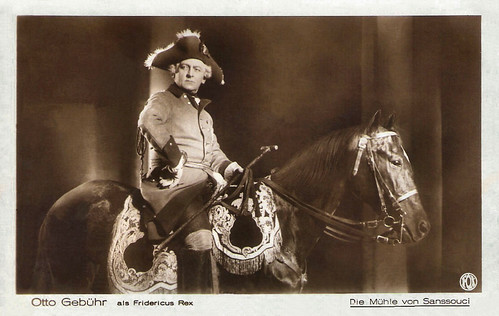
German postcard by Ross Verlag. Photo: Fox. Otto Gebühr as King Frederick the Great in the German silent film Die Mühle von Sanssouci/The Mill of Sanssouci (Friedrich Zelnik, Siegfried Philippi, 1926).
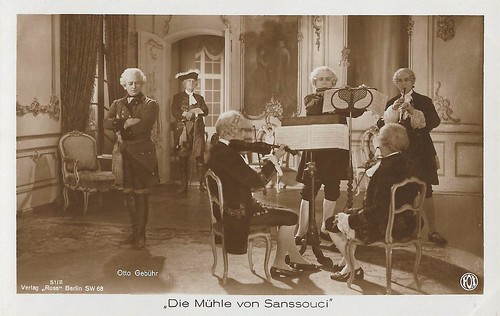
German postcard by Ross Verlag, no. 51/2. Photo: Fox. Publicity still for Die Mühle von Sanssouci/The Mill of Sanssouci (Friedrich Zelnik, Siegfried Philippi, 1926) with Otto Gebühr and Olga Tschechowa as Barberina.
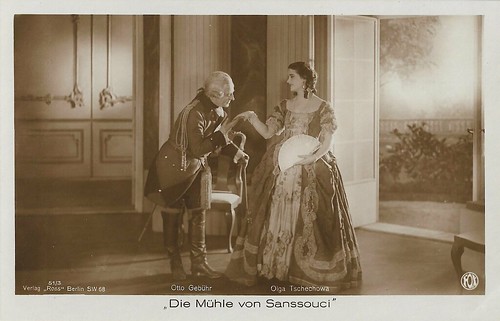
German postcard by Ross Verlag, no. 51/3. Photo: Fox. Publicity still for Die Mühle von Sanssouci/The Mill of Sanssouci (Friedrich Zelnik, Siegfried Philippi, 1926) with Otto Gebühr and Olga Tschechowa as Barberina.
Die Mühle von Sanssouci/The Mill of Sanssouci (Friedrich Zelnik, Siegfried Philippi, 1926) tells of an episode from the life of the Prussian King Frederick II, (Otto Gebühr) beyond the usual bouts of battle and court ceremonies. The year is 1750. After the end of the Silesian Wars, Friedrich returns exhausted to Sanssouci and wants to recover from the turbulent war events.
But the mill of miller Casper (Jacob Tiedtke), once the noblest and most expensive in the world, rattles so loud that his majesty feels his need to rest massively disturbed. Not even a new directive of the monarch changes the situation because Casper is more than stubborn. He refers to the King's decree that before the law in Prussia, all people are equal: the citizen as the nobleman, the beggar as the king.
Soon, the dispute escalates, and Casper decides to even bring about a court verdict on this matter. Friedrich knows that he can only lose it in front of Justitia in view of the equality rule he has set up. But finally, the two fighting roosters decide to find an out-of-court solution that will allow for reconciliation.
In the various subplot lines, his majesty can promote the love of two couples, including two of his soldiers (Lieutenant von Bärenfels - Georg Alexander - and Corporal Jobst - Wilhelm Dieterle), exchange ideas with the great French writer Voltaire (Karl Götz), and finally in his own, to push forward matters in his relationship with the dancer Barberina (Olga Tschechowa).
Die Mühle von Sanssouci/The Mill of Sanssouci was shot in November-December 1925 at the Staaken studios in Berlin and had its premiere on 1 February 1926 at the Berlin cinema Kino am Zoo. While Siegfried Philippi was the director, Friedrich Zelnik had the supervision. Art direction was by Andrej Andrejew and Gustav A. Knauer.
The Austrian Paimann’s Filmlisten summarised: "The mostly historical plot is interesting and not too lengthy, with many grazing lights, the direction tight, the presentation consistently good, excellent Otto Gebühr as Frederick the Great. Presentation and photography are also very good."

German postcard by Ross Verlag, no. 51/4. Photo: Fox. Publicity still for Die Mühle von Sanssouci/The Mill of Sanssouci (Friedrich Zelnik, Siegfried Philippi, 1926) with Otto Gebühr and Jacob Tiedtke as miller Casper.
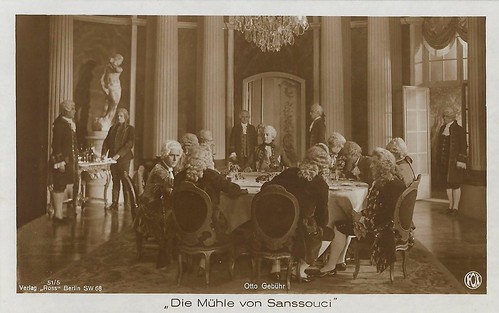
German postcard by Ross Verlag, no. 51/5. Photo: Fox. Publicity still for Die Mühle von Sanssouci/The Mill of Sanssouci (Friedrich Zelnik, Siegfried Philippi, 1926) with Otto Gebühr.
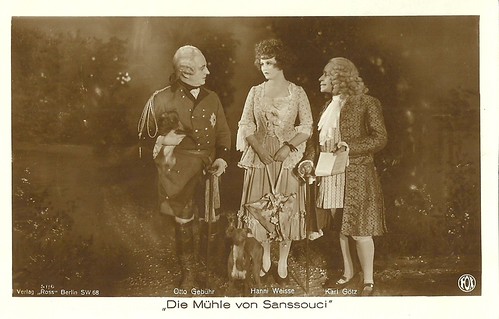
German postcard by Ross Verlag, no. 51/6. Photo: Fox. Publicity still for Die Mühle von Sanssouci/The Mill of Sanssouci (Friedrich Zelnik, Siegfried Philippi, 1926) with Otto Gebühr, Hanni Weisse as Henriette, and Karl Götz as Voltaire.
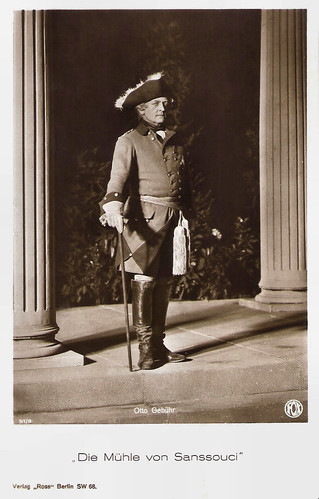
German postcard by Ross Verlag, no. 51/9. Photo: Fox. Otto Gebühr as King Frederick the Great in the German silent film Die Mühle von Sanssouci/The Mill of Sanssouci (Friedrich Zelnik, Siegfried Philippi, 1926).
Source: Wikipedia (German and English) and IMDb.

German postcard by Ross Verlag. Photo: Fox. Otto Gebühr as King Frederick the Great in the German silent film Die Mühle von Sanssouci/The Mill of Sanssouci (Friedrich Zelnik, Siegfried Philippi, 1926).

German postcard by Ross Verlag, no. 51/2. Photo: Fox. Publicity still for Die Mühle von Sanssouci/The Mill of Sanssouci (Friedrich Zelnik, Siegfried Philippi, 1926) with Otto Gebühr and Olga Tschechowa as Barberina.

German postcard by Ross Verlag, no. 51/3. Photo: Fox. Publicity still for Die Mühle von Sanssouci/The Mill of Sanssouci (Friedrich Zelnik, Siegfried Philippi, 1926) with Otto Gebühr and Olga Tschechowa as Barberina.
The legend of a loudly rattling mill
Die Mühle von Sanssouci/The Mill of Sanssouci (Friedrich Zelnik, Siegfried Philippi, 1926) tells of an episode from the life of the Prussian King Frederick II, (Otto Gebühr) beyond the usual bouts of battle and court ceremonies. The year is 1750. After the end of the Silesian Wars, Friedrich returns exhausted to Sanssouci and wants to recover from the turbulent war events.
But the mill of miller Casper (Jacob Tiedtke), once the noblest and most expensive in the world, rattles so loud that his majesty feels his need to rest massively disturbed. Not even a new directive of the monarch changes the situation because Casper is more than stubborn. He refers to the King's decree that before the law in Prussia, all people are equal: the citizen as the nobleman, the beggar as the king.
Soon, the dispute escalates, and Casper decides to even bring about a court verdict on this matter. Friedrich knows that he can only lose it in front of Justitia in view of the equality rule he has set up. But finally, the two fighting roosters decide to find an out-of-court solution that will allow for reconciliation.
In the various subplot lines, his majesty can promote the love of two couples, including two of his soldiers (Lieutenant von Bärenfels - Georg Alexander - and Corporal Jobst - Wilhelm Dieterle), exchange ideas with the great French writer Voltaire (Karl Götz), and finally in his own, to push forward matters in his relationship with the dancer Barberina (Olga Tschechowa).
Die Mühle von Sanssouci/The Mill of Sanssouci was shot in November-December 1925 at the Staaken studios in Berlin and had its premiere on 1 February 1926 at the Berlin cinema Kino am Zoo. While Siegfried Philippi was the director, Friedrich Zelnik had the supervision. Art direction was by Andrej Andrejew and Gustav A. Knauer.
The Austrian Paimann’s Filmlisten summarised: "The mostly historical plot is interesting and not too lengthy, with many grazing lights, the direction tight, the presentation consistently good, excellent Otto Gebühr as Frederick the Great. Presentation and photography are also very good."

German postcard by Ross Verlag, no. 51/4. Photo: Fox. Publicity still for Die Mühle von Sanssouci/The Mill of Sanssouci (Friedrich Zelnik, Siegfried Philippi, 1926) with Otto Gebühr and Jacob Tiedtke as miller Casper.

German postcard by Ross Verlag, no. 51/5. Photo: Fox. Publicity still for Die Mühle von Sanssouci/The Mill of Sanssouci (Friedrich Zelnik, Siegfried Philippi, 1926) with Otto Gebühr.

German postcard by Ross Verlag, no. 51/6. Photo: Fox. Publicity still for Die Mühle von Sanssouci/The Mill of Sanssouci (Friedrich Zelnik, Siegfried Philippi, 1926) with Otto Gebühr, Hanni Weisse as Henriette, and Karl Götz as Voltaire.

German postcard by Ross Verlag, no. 51/9. Photo: Fox. Otto Gebühr as King Frederick the Great in the German silent film Die Mühle von Sanssouci/The Mill of Sanssouci (Friedrich Zelnik, Siegfried Philippi, 1926).
Source: Wikipedia (German and English) and IMDb.
No comments:
Post a Comment